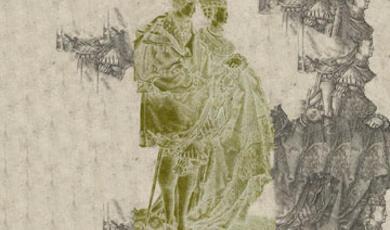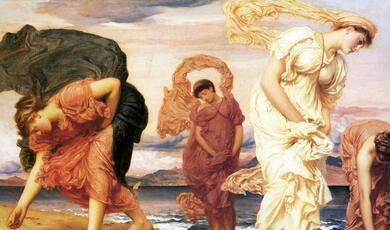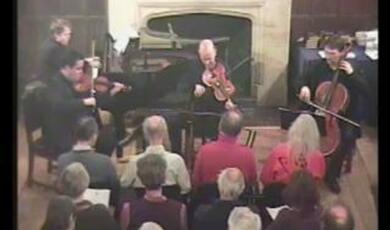15 JANUARY 2014
MUSIC IN CONTEXT:
IN ADVERTISING – RAVEL AND SAINT SAENS
DR STEPHEN ROSE
Welcome to this lecture, the theme of which is music in advertising.
By way of introduction, I wanted to ask: why do composers write music? Is it because of inspiration welling up from inside them, or because of external factors, like the commission of patrons? How to balance the internal and the external, to balance inspiration versus commission, is an age-old dilemma for composers. Today, we will look at two examples of music that were written for apparently the most external of reasons, for advertising, to sell something. The first piece is Maurice Ravel’s Introduction and Allegro, written on the commission of the Erard firm of piano and harp-builders to showcase the abilities of an Erard pedal-harp. The second piece is Saint-Saens’ Fantaisie for violin and harp, written to publicise the skills of a musical due of two sisters. Before I talk about these works and before our musicians play them, I will offer some general thoughts on composers writing things to commission and on music being used in advertising.
First, some general thoughts on composers writing music to commission. Some composers have hated the constraints of writing music to a detailed brief, but others have found these constraints to be a source of creative stimulus. I will just give some examples from across the centuries of music history.
In the seventeenth century, composers usually expected to write whatever their patron or boss demanded, but not all musicians liked this. Claudio Monteverdi, one of the first composers of opera, working in Northern Italy in the 1600s, regularly complained about having to write to the command of his Prince. He refused to compose music hastily or badly, and he would take up to a week to write a madrigal, so a simple setting of a few lines of poetry, a vocal setting, and his patron was not always happy about him writing music so slowly.
Sometimes, Monteverdi refused altogether to do what was requested. In 1616, he refused to set a libretto that told a story about the sea, a maritime tale. He refused to set it to music because the characters, he thought, were so ridiculous. They included characters representing the winds, and he said: “How can I imitate the speech of the winds if they do not speak? Music can imitate, without any words, the noise of the words, of winds and the bleating of sheep. It can imitate the neighing of horses and so on and so forth, but it cannot imitate the speech of the winds because no such thing exists.”. So, Monteverdi was bold enough, he had enough confidence in his status as a composer to refuse some of the things being demanded of him by his patron.
Into the nineteenth century, composers increasingly regarded themselves as autonomous artists, subject not to the dictates of external commission, but following only inspiration. Beethoven refused to accept a regular position at a court because he did not want to have to write things on demand for an aristocratic patron, and when he did get a commission, for instance, in 1823, he got a commission from London’s Philharmonic Society to write his Ninth Symphony, when he did get the commission, he sometimes resented it, and he said, “If I were not so poor as to have to live by my pen, I would not accept anything from the Philharmonic Society.” So, ideally, he would not have accepted a fee from the Philharmonic Society. Ideally, perhaps, he might not have even written his Ninth Symphony, in his world of wanting to be an autonomous composer. Around the same time, he failed to deliver other commissions, such as an oratorio called “The Victory of the Cross” because he did not like the subject or the text.
Now, this situation changed in the twentieth century, the period from which the music today that we are to hear comes from. In the twentieth century, there was a reaction against the romantic idea of a composer as a lonely genius working only to the dictates of their inspiration.
So, Igor Stravinsky, composer of ballets like the Firebird and, later, neoclassical music, he wrote: “A mode of composition that does not assign itself limits becomes pure fantasy. The effects it produces may accidentally amuse, but are not capable of being repeated. My freedom consists in my moving about within the narrow frame I have assigned to myself for each one of my undertakings. The more constraints one imposes, the more one frees oneself of the claims that shackle the spirit.” So, for Stravinsky, an exacting and detailed commission was actually a source of creative stimulus rather than something to feel upset and resentful about.
From the middle of the twentieth century, composers have increasingly had to face extreme constraints if they have written music for film or TV or media. In the 1930s, the rise of films with soundtracks led to a new type of commission for composers, where they had to tailor their music to a film scenario, to its narrative pace, to the emotions of a character. They had to write music that was of a precise length, down to the nearest second, and more recently, film and TV composers have written so-called library music, where their soundtrack is categorised with various adjectives describing its mood, and can be used in a variety of programmes. You may have had that experience of watching a television programme and thinking “I actually recognise that music from a previous series or a completely different programme,” and that is because the programme is using this so-called library music, where a composer has written music that is supposed to represent joyfulness or the sun rising, and that music will then be reused whenever the producer of a film or a TV programme enters those particular emotional keywords into the database of library music.
You are probably wondering: what has this got to do with Ravel and Saint-Saens, the composers that we focus on today? Of course, they pre-date the era of film and media music, but it still seems that neither resented writing to a commission in these two pieces which we are going to hear. The pieces which we are going to hear perhaps exemplify Stravinsky’s notion of how creativity can be inspired by writing to a particular brief, for instance, writing to show off the capabilities of a pedal-harp.
So, those were a few thoughts on writing music to commission. The other theme of course is music in advertising, and I will just say a few words on that. The role of music in advertising recognises that music is a really powerful tool at selling things.
Since the Ancient Greeks, music has been recognised as a powerful emotional force. The rhythms and melodies of music can help words to stick in the brain much more effectively than if those words were delivered as speech alone, and music can also convey a particular mood. The Ancient Greeks believed that music was such a powerful force that it could stir men into bravery on the battlefields or it could impose moral order and civilising harmony on unruly schoolboys.
In the sixteenth century, religious reformers such as Martin Luther used the pneumonic force of music to impress religious doctrines on people, devising songs that contained the key points of Protestant belief.
By the twentieth century, the capitalist age, music’s emotional force was irresistible to advertisers, who wanted to brainwash their audiences into buying their products. Mass advertising, using soundtracks, began in the 1920s and 1930s, with commercial radio in the United States, and by the 1950s, most radio advertisements included an advertising jingle, a little catchy song, normally setting cheesy words, which would promote products as diverse as Happiness candy, or Barbasol razors, or Wheaties breakfast cereal, to name some examples from America, where the art of the advertising jingle was perhaps most developed. So, these jingles would set trite little rhymes, like “Pepsi Cola’s up-to-date, for modern folks who watch their weight, we made it light and dry for you, refreshing without filling too,” which the words may not be very inspiring, but perhaps, when set to a suitable jingle, they will start to worm their way into your brain and put you into the mind that you absolutely must buy Pepsi Cola.
Music has also been central to television advertising since the 1950s, and particularly because music can convey an emotional or subliminal message. A recent book by someone called Timothy Taylor – the title is “The Sounds of Capitalism” – it includes an interview with someone called Mitch Miller, who was a Head of Artists at Columbia Records in the 1960s, and Mr Miller described admiringly how music had been used in a TV commercial to sell Ford cars in 1959. Ford wanted to sell a particular car because it was an economy model, and they wanted to point out to potential buyers that it would actually save lots of money on miles per gallon and things like that, but they worried that that might make the vehicle be perceived as low quality. So, to avoid this, they accompanied the advert with a soundtrack using lush string music, not usually associated with low price items, and apparently, the sales rocketed and the advert was judged a massive success because of the subliminal message of high quality given by the lush string quartet tones.
The pieces in today’s lecture are by Ravel and Saint-Saens, and present a more rarefied form of advertising, because both promote musical items: Ravel is advertising a type of harp; and Saint-Saens is advertising the musical skills of an ensemble that consists of two sisters. So, Ravel and Saint-Saens did not have to set a cheesy jingle to music, they did not have to convey a subliminal message that people should buy a certain product. Instead, they had to show the musical abilities of the ensemble for which they were writing, the musical abilities of the harp in the Ravel piece and, in the Saint-Saens piece, the musical abilities that could be achieved by this unusual combination of violin and harp. So, these pieces are not advertising in the sense of a radio jingle or TV commercial music, but they are advertising in a different way, and I am sure, had Beethoven been asked to write these pieces in the nineteenth century, with such a commercial agenda in mind, he might have recoiled from the prospect of his music being used in such a commercial, undignified, unnoble manner.
Those are some initial thoughts on music being written to commission and music in advertising. We are now going to move our focus on to the Ravel piece, Ravel’s Introduction and Allegro, and I will ask the players for Ravel to come up now…
Before the players start, I am just going to give you a bit of background about this piece, and then we will point out some themes, some little extracts that you should listen for when the whole piece is played in a few minutes’ time.
This piece was commissioned in 1905 by Erard, a firm that manufactured pianos and harps, and it was commissioned as a showcase for the company’s harps. To explain why this was important, I need to take you a little bit into the history of the harp, and to the rivalry between harp manufacturers at the start of the twentieth century.
Around 1900, all manufacturers wanted to make a harp that could play chromatic notes. Now, chromatic notes are the black notes on a piano keyboard, and these black notes were increasingly important in the harmonies of late-nineteenth century music, as composers sought to write music that was more and more expressive, which was more and more luxuriant harmonically, which pushed the boundaries of harmonies.
So, one way to get these extra notes was an instrument called the chromatic harp, which was devised by the firm of Pleyel in 1894. This had one rank of strings, with the diatonic notes, that is the same as the white notes on the piano, and a second rank of chromatic strings, so almost like the black notes on a piano. In 1904, the year before this Ravel piece we will shortly hear, Pleyel commissioned the French composer Debussy to write his “Danse sacree et danse profane” for the chromatic harp, so this was a piece to advertise the abilities of Pleyel’s patented chromatic harp. It was partly intended for conservatory students in Paris, so that they would have a test piece that they could play in their auditions and their recitals, and it was also partly to show off this chromatic harp and what it could do to possible buyers.
But there was a rival type of harp, which was built by the Erard firm, and this was a harp that had pedals, and the harp that Klara is playing today is a pedal-harp. Some of you may even be able to see the pedals at the bottom. So, the idea of a pedal-harp is that, here, the chromatic notes are obtained by using the pedal, which will either lengthen or shorten the string, and by lengthening or shortening the string, that makes the note slightly higher or lower. So, Klara, do you want to give us a little demonstration of what happens when you use the pedals?
[Musician plays]
Thank you. By using the pedals, you get these little alterations of notes, these chromatic alterations, and it probably means that your harp needs about half of the strings that a chromatic harp would have, I think – maybe, maybe not. I am not sure, I am not a harp specialist.
Anyway, this was the Erard harp, a harp that used pedals, and one year after Pleyel had commissioned Debussy to showcase the chromatic harp, Erard retaliated by commissioning Ravel, a sort of younger generation of composer than Debussy, for a piece that would show the full technical and expressive power of the pedal-harp. So, this is the kind of advertising significance of the piece, within a marketplace in which there were two rival designs of harp. It was really important for Erard to be able to show that their harp could do something much more amazing than the chromatic harp, and that was probably the brief that was given to Ravel: to show off the abilities of this harp to the upmost – can you something better than Debussy in his piece from a year earlier?
Now, Ravel wrote his Introduction and Allegro quickly. He said, in a letter, it took him eight days of solid work and three sleepless nights, and he said that allowed him to finish it, for better or worse. So, I have this vision of him working in a kind of white-heat of creativity, which does actually contrast with the usual image of Ravel as a fastidious and careful composer who takes a lot of care, particularly with his orchestration, and Ravel’s orchestration is famously delicate and subtle.
Ravel often explains how composing, for him, was normally quite a laborious effort, more perspiration than inspiration. When he talked about his G Major Piano Concerto, which he wrote in about 1930, he said: “The opening theme came to me on a train between Oxford and London, but the initial idea is nothing. We have gone past the days when the composer was thought of as being struck by inspiration, feverishly scribbling down his thoughts on a scrap of paper. Writing music is 75% an intellectual activity. This effort is often more pleasant for me than having a rest”. So, Ravel enjoyed the perspiration, the re-drafting, the throwing out of things that did not quite work. He enjoyed the sheer effort spent in composition and he was definitely not of the view that music came as inspiration to a genius. His view of creativity probably made him more amenable to accepting a commission from a firm like Erard, and he must have had to write quite fast with huge intensity, to get this piece finished in just eight days.
The piece consists of two movements, which flow into each other without a break. It starts with a slow introduction, and then goes into an allegro, a faster movement, and you can see that there is quite a big ensemble: a string quartet, two woodwind instruments, plus the harp. But the harp definitely takes centre stage, and in fact, the harp even has a small cadenza near the end of the fast movement, and the effect of the string quartet and the flute and the clarinet is partly to give this soft, voluptuous sound that contrasts with the more percussive tone of the harp, and Ravel creates here a very unusual and memorable sound world. It gives a dreamlike fantasy effect, particularly because he uses some delicate, unusual, almost experimental techniques from, for instance, the woodwinds, double-tonguing, which gave a delicacy and an unusual effect in the woodwind parts.
I am just going to point out to you some of the themes to listen out for in the piece, but, before that, I will just give the musicians a chance to tune up.
[Musicians play]
I will just point out a few themes to listen out for because I think, if you understand the themes that Ravel uses, you then have something to have a grip on in this otherwise fantasy-like, dreamlike musical construction.
The piece starts with a slow introduction, and immediately, at the start, there are two themes: first of all, a theme in the flute in the clarinet, which consists of some interlocking jumps of a fifth, so quite a big interval, and Luke and Leonie will play this opening woodwind theme for us.
[Music plays]
So, that is the first theme, those interlocking fifths, and then, that is immediately answered by a second theme in the strings, and this uses a slightly smaller interval of a fourth, and at first, it slides down the fourth in steps, and then we hear the fourth used as a jump.
[Music plays]
That is the second theme, and when we get to the allegro, the fast section, that second theme, the one we have just heard, is re-worked on the harp, and it is re-worked into a faster version, with waltz rhythms, one-two-three, one-two-three, and now there is an uncertainty and ambiguity of what the key is. We might think that perhaps the key is E Flat Minor – Klara, do you want to play E Flat…?
[Note plays]
Or we might think that possibly the key is G Flat, because the piece subsequently ends in G Flat…
[Note plays]
So, there is that uncertainty, which of those chords is actually the centre of the piece, and, at the moment, we have the second theme and we just do not really know. It is in this delicious ambiguity… Klara, if you want to play it…
[Music plays]
That is the second theme re-worked into that ambiguous waltz version. Later on, another theme comes – I am at figure six - and this is another waltz theme. It is less ambiguous in terms of what is the key, what is the tonal centre. Do you want to play figure six please?
[Music plays]
That is another theme to listen out for, and Ravel then starts combining these different themes, in always very subtle ways. So, you are now going to hear figure eight, where we have quite fast versions of both of the opening themes, the themes we heard in the slow introduction, and they are now played in waltz time, and, first of all, we have the first theme, which was originally played on the woodwind, but now it is being played in the string quartet, and against that, we have the second theme, the one which was originally played on the high strings, but now it is being played on the harp. So, this is figure eight, where the themes start to be combined…
[Music plays]
And now, I will stop talking and I will leave it to the musicians to play a complete performance of Ravel’s Introduction and Allegro for Harp, with accompaniment of string quartet, flute and clarinet.
[Music plays]
Thank you very much to the Royal Academy musicians for that performance of Ravel, which I hope would have inspired any of you with a spare few thousand to buy a harp, to go off and buy an Erard harp, if you had been here in 1905.
We are now going to move to our second musical composition, a piece by Saint-Saens, his Fantaisie for violin and harp, which was also written as form of musical advertising. It was written for two musical sisters, Clara Eisler, a harpist, and Marianne Eisler, a violinist, so it showcases their own abilities and also the unusual combination of these two instruments. It is quite unusual to have a violin piece accompanied by harp, and more usually, it is a combination of violin and piano. Saint-Saens wrote the piece in March in 1907, so two years after Ravel wrote his Introduction and Allegro, and he wrote it in about ten days, so working at a similar speed to Ravel, quite fast, although Saint-Saens re-used some material from an earlier piano piece in this violin and harp piece.
By this stage, in 1907, Saint-Saens was the grand old man of French music. He had got to the stage in his career where he was being honoured with statues being erected in his fame, even though he was still alive. Normally, statues only come when you have died. The piece was premiered on the 3rd of July 1907, at the Aeolian Hall in London, so an interesting example of a French composer choosing to have his work premiered in London, and it received an enthusiastic response from the London audience, and Marianne Eisler, the violinist, described it as “the great success of our career”.
Now, in terms of timbre and instrumental technique, you will immediately notice that Saint-Saens’ music is not as innovative as Ravel’s. He does not create that kind of dreamlike sound world that Ravel created in the Introduction and Allegro, and in fact, in some ways, you could imagine this being a piece for violin and piano, that it is less a showcase of the unusual capacities and the technical abilities of the harp, more, you know, a duo between two instruments. Rather than exploring timbre and sound world, Saint-Saens is really interested in references to previous types of music, and I will point some of these out as we just go through the piece and have a few extracts.
But, first of all, do you want to tune up?
[Musicians play]
So, the piece is in a chain of sections, and it flows from one to another without a break, and I will just point out what these sections are, so you have something to listen out for as the piece unfolds.
It starts off with an improvisatory introduction, in which there are downward arpeggios, downward broken figures in the harp, and above this, the violin slowly breaks into melody. It almost stutters at the start, and then, eventually, an unbroken violin melody emerges.
From that introduction, we move into a faster section, an allegro, in which the violin has a forthright melody, and the harp appears to be playing in a different key, so a slightly puzzling moment…
[Music plays]
And then, moving towards the middle of the piece, towards the climax, there is a rather unusual section called “Vivo e grazioso”, an Italian tempo-marking that suggests this section should have a mix of vigour and yet gracefulness, and here, there is a dialogue between rather skittish violin writing and chords in the harp. It reminds me a little bit of a scherzo, which are those movements that Beethoven started to write in his symphonies and his sonatas. Rather than writing a minuet, he wrote a scherzo, which was a slightly crazy, skittish dance movement. But, here, Saint-Saens is writing in five-four, a really unusual time signature for the period, and not one that Beethoven would have used in his scherzos. Even in this section, there are also occasionally more lyrical moments for the violin. So, this is a little taste of the “Vivo e grazioso” section in the middle…
[Music plays]
And we then move into the Andante, which, for me, is the most memorable part of this sonata. It is built on a repeated bass theme, what English seventeenth century composers would call a ground bass, and in fact, the theme that Saint-Saens uses is the same sort of theme that you might find in a piece by Purcell or a piece by Monteverdi or these seventeenth century composers. So, the harp has this obsessively repeated theme, as the harmonic foundation, and above that, the violin has little snatches of melody, and then it breaks into faster figures, more impassioned runs, eventually double-stopping and more virtuosic things. So, this is the kind of emotional still centre of the piece…
[Music plays]
So, that is an example of Saint-Saens again referring to the work of previous composers, sort of invoking music history in this piece, and whereas Ravel was devising a dreamlike sound world, Saint-Saens is creating these kind of references to what has gone before him musically.
And then the piece ends with recollections of the opening two sections, recollections of those improvisatory harp arpeggios and that more forthright melody, eventually bringing the piece to a delicate pianissimo ending.
Now, let us hear the whole of Saint-Saens’ Fantaisie for violin and harp…
[Music plays]
So, in conclusion, we have had two pieces written within two years of each other, both to showcase the harp, but in very different ways. Both composers, Ravel and Saint-Saens, rose to the challenge of their brief, and to paraphrase Stravinsky, both of them found huge diversity and invention within “the narrow frame assigned to them”. From these constraints of advertising come creativity.
© Dr Stephen Rose, 2014


 Login
Login








